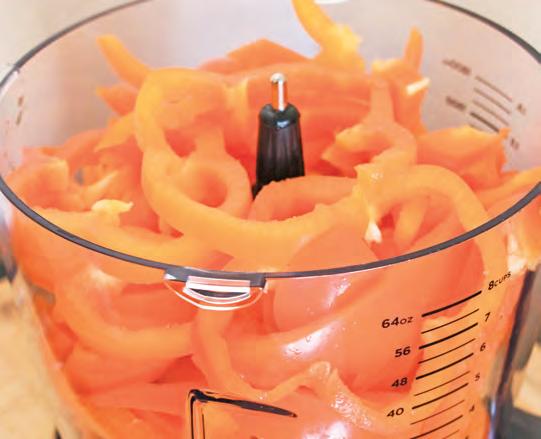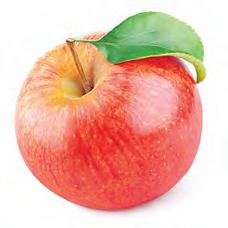
5 minute read
Raising Children Making food and feeding babies
Doctors adjust recommendations about starting solids
PHOTOS AND STORY BY ADELLE WHITEFOOT
Ever since I became a mom, I’ve spent more time reading labels on everything I buy from formula to food pouches to baby oatmeal to food jars. I’ve learned a lot from looking at these labels.
For instance, when we decided to switch to formula, I did a bunch of research, and everything I read said the same thing: make sure the formula is made with milk.
My son suffered from acid reflux, so the first formula containers I looked at were for spit-up, and I was saddened to see that the first ingredient on the list was corn syrup. It was the same for sensitive stomach. From then on, I read every label.
When my son was showing signs of wanting to try solid food, I knew before looking at the labels that I was going to make my own, especially since I got a Ninja Kitchen System for Christmas the year before. But I wanted to get a food pouch or jar from the store before I committed to making a large batch of homemade food that he wasn’t ready to eat.
So again, I started to look at labels. What I found was that the jars of food I was fed as a baby had a lot of salt in them. I did find an organic food pouch that only had the fruits and vegetables listed in its ingredients, and that’s how I found out that my son really, really likes apples and sweet potatoes.
Making my own food
My son is about 6 months old and can’t feed himself yet, so once a month, I make him food.
I buy vegetables and fruits and blend them into purees with my Ninja food processor attachment. I freeze the purees, which can be stored in zip-close freezer bags for up to three months.
The way I freeze the food is by filling up WeeSprout rubber freezer trays. Each cube is 1.5 ounces when filled to the top, and there is also a 1-ounce mark on the inside for smaller portions. Each tray comes with a lid, so the food is covered and the trays are stackable.
Here’s how I make the purees:
First, I cut up the vegetable or fruit, then I throw it in a pot to either boil or steam, depending on the food. For instance, I boil apples and sweet potatoes, but I steam carrots and cauliflower. Doing this makes the food softer, so when you puree it, it’s less chunky. Some fruits, like bananas or berries, I will just throw in the food processors as is.
My Ninja has a puree button, so I just push that, and it purees for about two minutes. You can add water to the puree gradually to get the consistency you prefer. Once the puree is made, I fill the trays, leave them in the freezer overnight and then pop out the frozen cubes and put them in zip-close freezer bags. I label the bags with the food name and the date.
My son’s favorite is apples and sweet potatoes with a little bit of cinnamon.
Sometimes, I mix the apples and sweet potatoes into one puree and other times I will freeze the purees separate and add one cube of each to a bowl and mix together.
To unfreeze the food, I take it out the night before and put it in a container with a lid in the refrigerator. If I forget, I’ll pop it in the microwave for about a minute in the morning and leave it on the counter to cool in a container with a lid and serve it to him in the afternoon.


Most of the purees I’ve made have been from trial and error, and you’ll find those recipes on these pages. But I recently purchased “The Big Book of Organic Baby Food” by Stephanie Middleberg, and I definitely recommend it, even if you don’t plan on buying organic food.
It has recipes and tips for foods from 6 months old all the way up to 18 months old, and it even includes a few recipes for family dinners. So far, I’m loving the book and can’t wait to try more of the complicated recipes.
Tips from a doctor


Dr. Addie Vittorio, a family physician with St. Luke’s Hospital, gave some tips for introducing foods to infants for the first time, and she put some myths to bed.

According to Vittorio, it is no longer recommended to introduce one vegetable or fruit at a time.
“In the past, parents would try carrots for three days, then try Dr.
beans for three days to make sure there was no reaction and it turns out that fruits and vegetables are not likely to be highly allergenic, so that practice is no longer recommended,” she said.

Also the myth that introducing a fruit to your infant before a vegetable means they won’t like vegetables later on, is just not true, Vittorio said. Doctors are now recommending introducing possible allergen foods — grains, nuts or dairy — to children sooner than later, unless there is a family history of the allergy.
“Parents would often worry that once their kids start taking solids that they still would avoid introducing them to allergens like dairy, seafood or nuts, and actually we recommend introducing allergens of all types,” Vittorio said. “Obviously, if there is a history of severe food reactions in the family, we would want you to be more cautious.”
The biggest thing when it comes to introducing solids to infants is that once you start, don’t stop.


“There is a gag reflex in all infants between 6 and 9 months, and it disappears when exposed to solids and our goal is to gradually get that gag reflex to disappear by exposing it to more and more solid foods over time,” Vittorio said. “When the baby is ready and wants to eat, I recommend that you feed at least once a day to keep those skills up.”
Vittorio recommended “Child of Mine: Feeding with Love and Good Sense” by Ellyn Satter for parents who want to learn more about introducing solids to their infants.
Vittorio said when it comes to deciding when to start your infant on solids there are signs to look for.
“When the child follows food, follows spoons or makes motions or gestures that they would like to try some of that, that is one of your cues,” she said. “The other cue would be being able to sit up mostly supported and keep their head and back in line. Usually that comes between 5 and 6 months old, but you don’t want a baby that is completely lumped over in a seat trying to eat something and being at risk for choking.”
And even if your infant isn’t eating solids yet, Vittorio recommended having them at the dinner table in a high chair while you eat.
“That allows you to have that bonding time even when they are not eating,” she said.
Apple Puree

• Peel, decore and slice six apples
• Put apple slices in a pot and cover with water
• Boil until apples are soft and tender
• Drain the pot
• Put apples in food processor or blender
• Add ½ teaspoon cinnamon (optional)
• Puree apples
• Mix in oats or cooked quinoa to thicken (optional)
Carrot Puree
• Add baby carrots to steamer
• Steam for 10-20 minutes, depending on amount
• Put steamed carrots in food processor or blender and puree
Apple and Sweet Potato Puree
• Peel, decore and slice three apples

• Peel and cut up five medium sweet potatoes
• Put apples and sweet potatoes in separate pots and cover with water
• Boil until apples are tender and sweet potatoes fall apart when poked with fork
• Drain both pots
• Put apples and sweet potatoes in food processor or blender
• Add ½ teaspoon cinnamon (optional)
• Puree apples and sweet potatoes
• Mix in oats or cooked quinoa to thicken (optional)










